Abstract
OBJECTIVE: To evaluate the efficacy of pentoxifylline therapy in improving the walking capacity of patients with moderate intermittent claudication. DATA SOURCES: A search of MEDLINE for trials published between 1976 and 1994 inclusive, and a bibliographic review of all articles retrieved. STUDY SELECTION: Randomized, placebo-controlled, double-blind clinical trials were selected that evaluated the pain-free walking distance (the distanced walked on a treadmill before the onset of calf pain) and the absolute claudication distance (the maximum distance walked on a treadmill) among patients with moderate intermittent claudication. Twelve study groups in 11 trials were included in the analysis. DATA EXTRACTION: In addition to information regarding the trial design, patient characteristics, dosages and treatment periods, the means and standard deviations were collected for both the pain-free walking and absolute claudication distances. Trial quality was also assessed. DATA SYNTHESIS: Overall, there was a statistically significant improvement in the pain-free walking distance after pentoxifylline therapy (weighted mean difference 29.4 m [95% confidence interval (CI) 13.0 to 45.9 m]); this finding was based on a total sample of 612 patients (308 in the treatment groups and 304 in the control groups). A significant improvement was also noted in the absolute claudication distance (weighted mean difference 48.4 m [95% CI 18.3 to 78.6 m]); this was based on a total sample of 511 patients (258 in the treatment group and 253 in the control group). In a sensitivity analysis of the pain-free walking distance, significant treatment effects and no statistically significant heterogeneity were found when only trials were included that were "medically eligible" (involved patients with stage II disease and a pain-free walking distance of 50 to 200 m). In a similar sensitivity analysis of the absolute claudication distance, the two conditions resulting in a significant treatment effect and no significant heterogeneity were the inclusion of "medically eligible" trials and those with a shorter treatment duration (13 weeks or less). CONCLUSION: Pentoxifylline therapy may be efficacious in improving the walking capacity of patients with moderate intermittent claudication. However, properly conducted clinical trials are required to provide a true estimate of the benefit.
Full text
PDF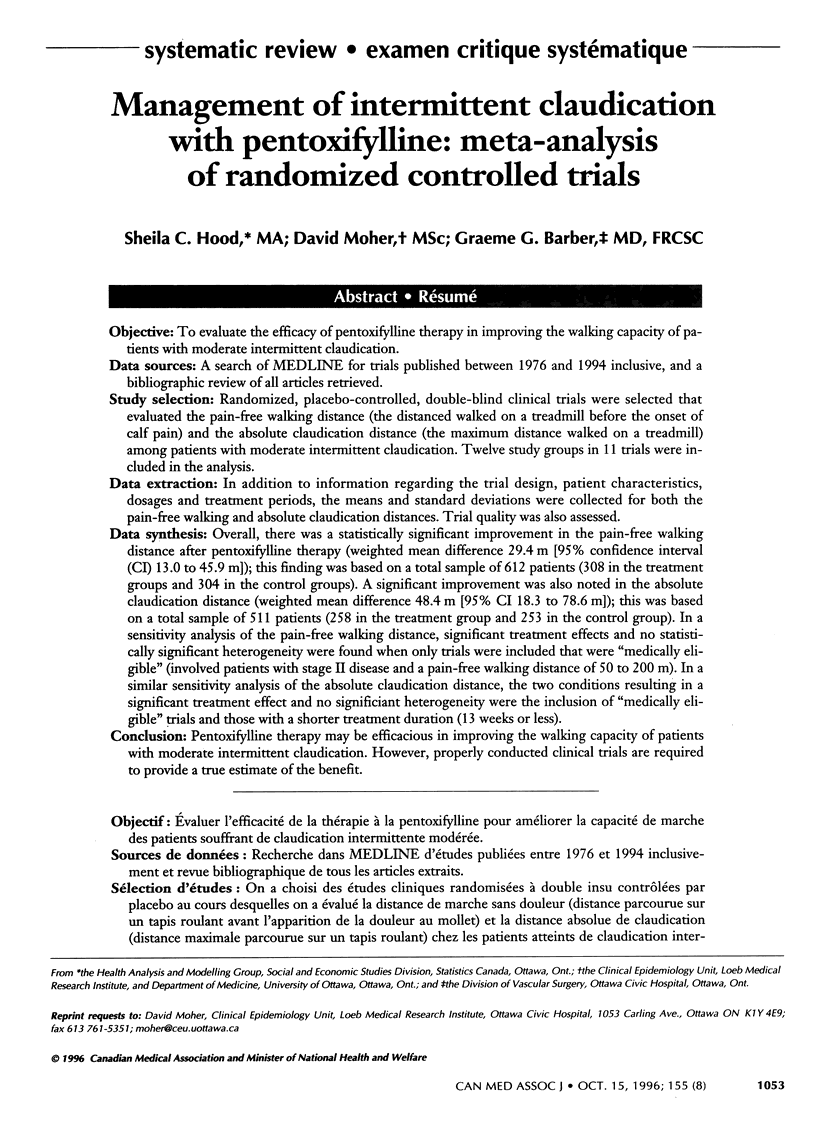
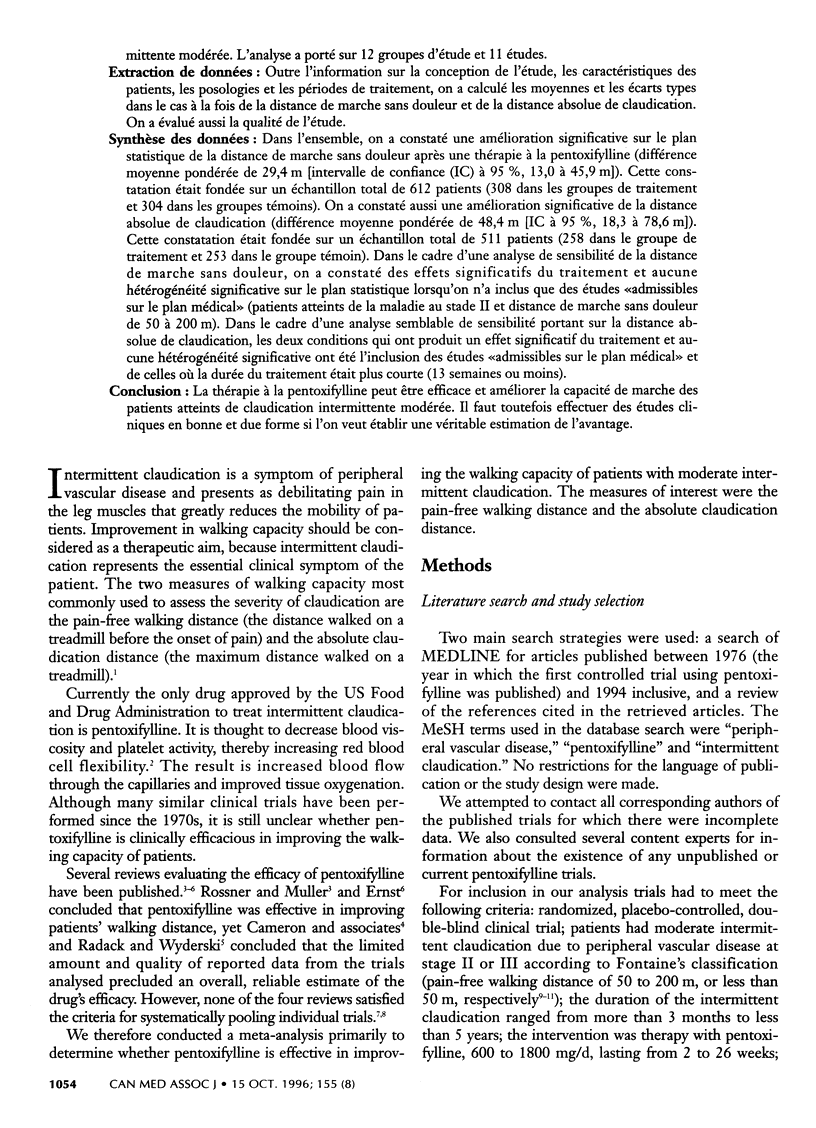

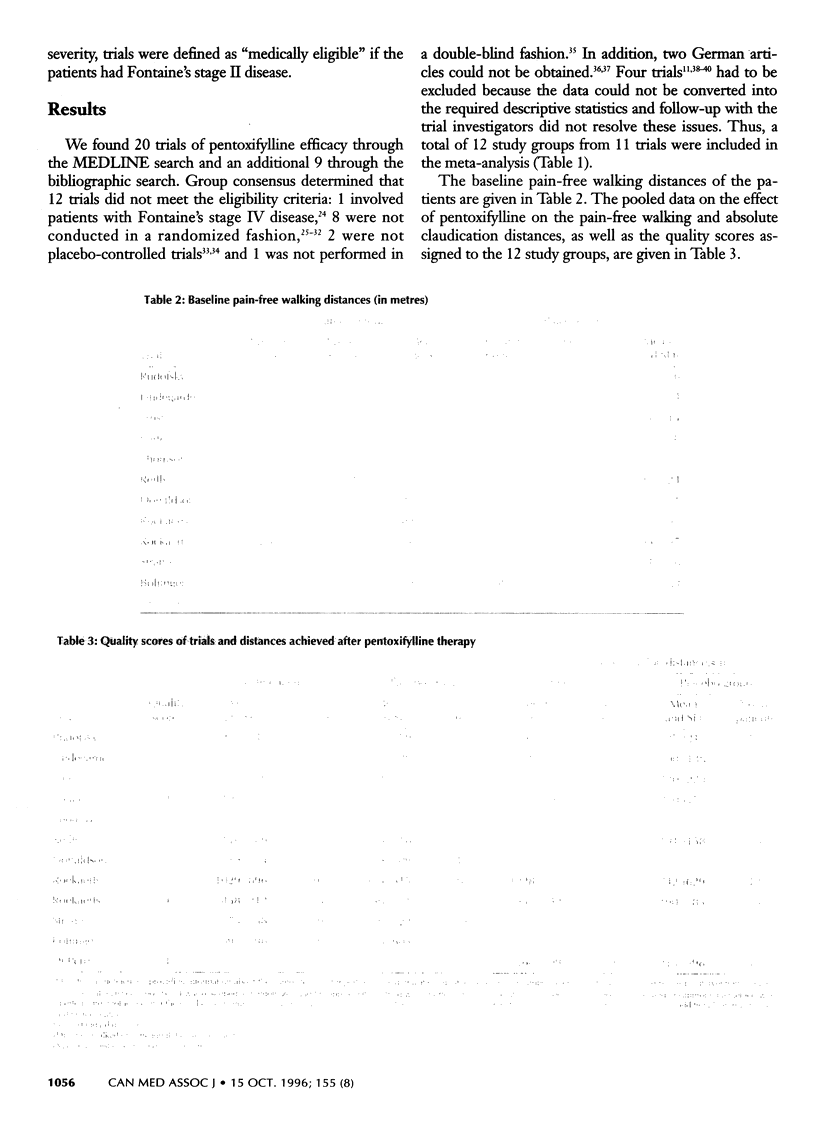
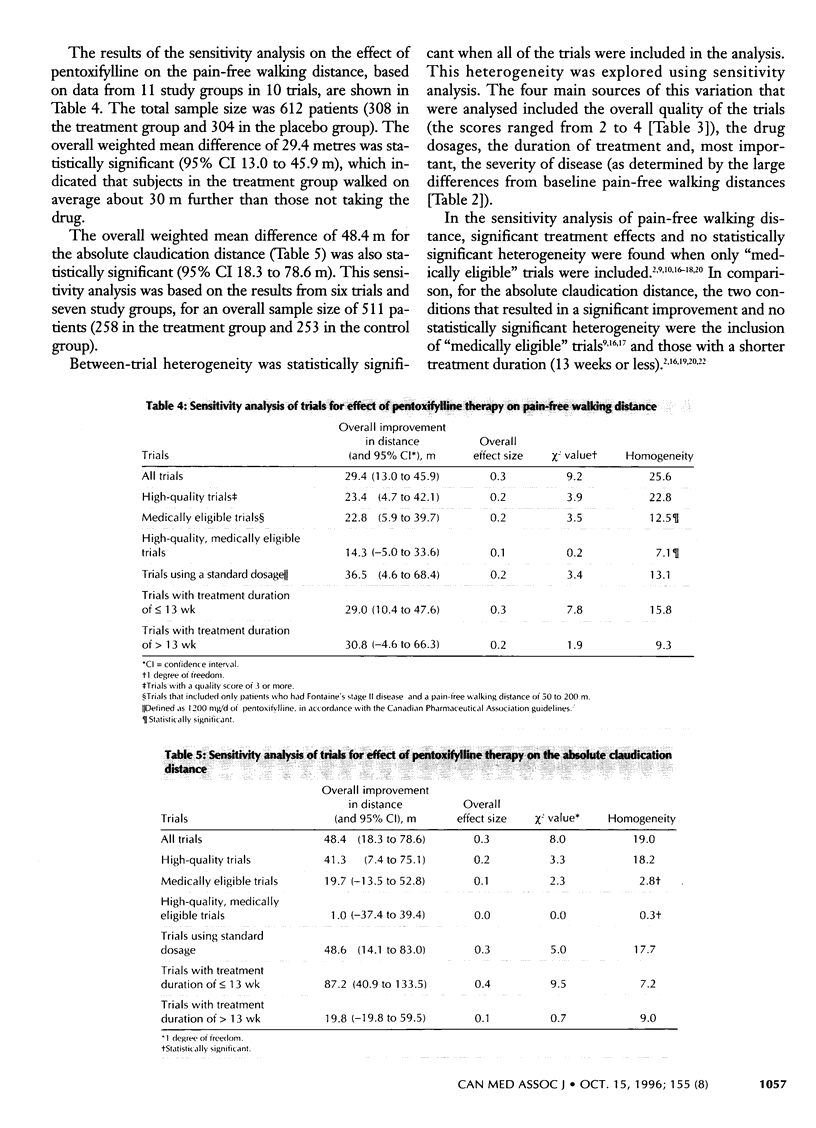
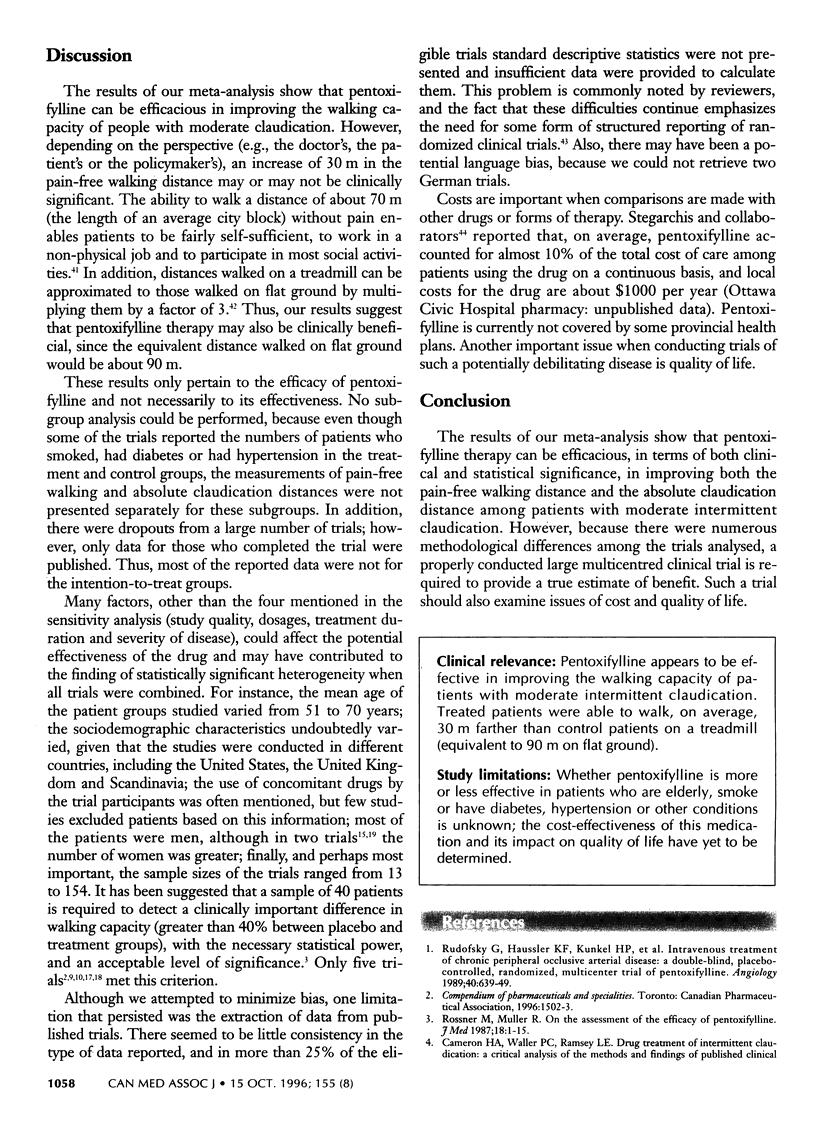
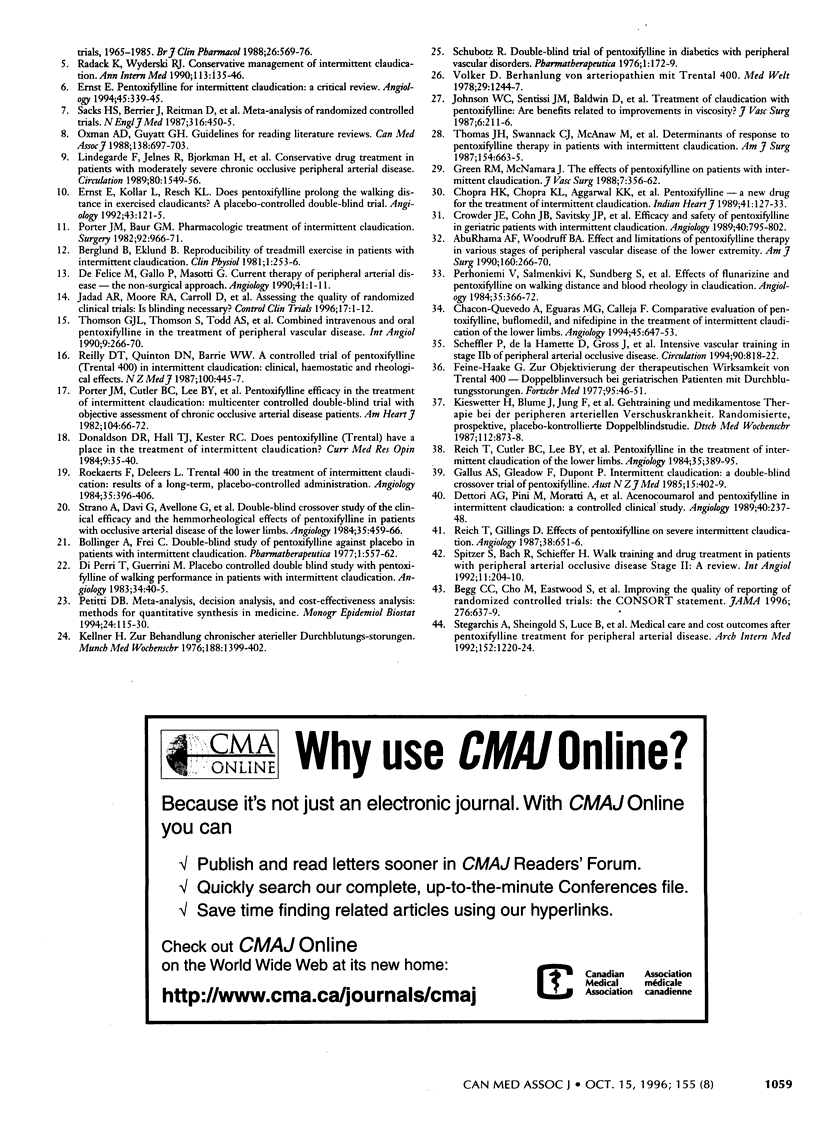
Selected References
These references are in PubMed. This may not be the complete list of references from this article.
- AbuRahma A. F., Woodruff B. A. Effects and limitations of pentoxifylline therapy in various stages of peripheral vascular disease of the lower extremity. Am J Surg. 1990 Sep;160(3):266–270. doi: 10.1016/s0002-9610(06)80020-6. [DOI] [PubMed] [Google Scholar]
- Begg C., Cho M., Eastwood S., Horton R., Moher D., Olkin I., Pitkin R., Rennie D., Schulz K. F., Simel D. Improving the quality of reporting of randomized controlled trials. The CONSORT statement. JAMA. 1996 Aug 28;276(8):637–639. doi: 10.1001/jama.276.8.637. [DOI] [PubMed] [Google Scholar]
- Berglund B., Eklund B. Reproducibility of treadmill exercise in patients with intermittent claudication. Clin Physiol. 1981 Jun;1(3):253–256. doi: 10.1111/j.1475-097x.1981.tb00893.x. [DOI] [PubMed] [Google Scholar]
- Chacón-Quevedo A., Eguaras M. G., Calleja F., Garcia M. A., Roman M., Casares J., Muñoz I., Concha M. Comparative evaluation of pentoxifylline, buflomedil, and nifedipine in the treatment of intermittent claudication of the lower limbs. Angiology. 1994 Jul;45(7):647–653. doi: 10.1177/000331979404500708. [DOI] [PubMed] [Google Scholar]
- Chopra H. K., Chopra K. L., Aggarwal K. K., Parashar S. K. Pentoxifylline--a new drug for the treatment of intermittent claudication. Indian Heart J. 1989 Mar-Apr;41(2):127–133. [PubMed] [Google Scholar]
- Crowder J. E., Cohn J. B., Savitsky J. P., Morgan D. L., Slywka J., Cobert B. L., Hryniewicki S. W., Piccirillo R. T., Wilcox C. S. Efficacy and safety of pentoxifylline in geriatric patients with intermittent claudication. Angiology. 1989 Sep;40(9):795–802. doi: 10.1177/000331978904000904. [DOI] [PubMed] [Google Scholar]
- De Felice M., Gallo P., Masotti G. Current therapy of peripheral obstructive arterial disease. The non-surgical approach. Angiology. 1990 Jan;41(1):1–11. doi: 10.1177/000331979004100101. [DOI] [PubMed] [Google Scholar]
- Dettori A. G., Pini M., Moratti A., Paolicelli M., Basevi P., Quintavalla R., Manotti C., Di Lecce C. Acenocoumarol and pentoxifylline in intermittent claudication. A controlled clinical study. The APIC Study Group. Angiology. 1989 Apr;40(4 Pt 1):237–248. [PubMed] [Google Scholar]
- Di Perri T., Guerrini M. Placebo controlled double blind study with pentoxifylline of walking performance in patients with intermittent claudication. Angiology. 1983 Jan;34(1):40–45. doi: 10.1177/000331978303400105. [DOI] [PubMed] [Google Scholar]
- Donaldson D. R., Hall T. J., Kester R. C., Ramsden C. W., Wiggins P. A. Does oxpentifylline ('Trental') have a place in the treatment of intermittent claudication? Curr Med Res Opin. 1984;9(1):35–40. doi: 10.1185/03007998409109556. [DOI] [PubMed] [Google Scholar]
- Ernst E., Kollár L., Resch K. L. Does pentoxifylline prolong the walking distance in exercised claudicants? A placebo-controlled double-blind trial. Angiology. 1992 Feb;43(2):121–125. doi: 10.1177/000331979204300205. [DOI] [PubMed] [Google Scholar]
- Ernst E. Pentoxifylline for intermittent claudication. A critical review. Angiology. 1994 May;45(5):339–345. doi: 10.1177/000331979404500502. [DOI] [PubMed] [Google Scholar]
- Feine-Haake G. Zur Objektivierung der therapeutischen Wirksamkeit von Trental 400. Doppelblind-Versuch bei geriatrischen Patienten mit Durchblutungsstörungen. Fortschr Med. 1977 Jan 6;95(1):48–51. [PubMed] [Google Scholar]
- Gallus A. S., Gleadow F., Dupont P., Walsh J., Morley A. A., Wenzel A., Alderman M., Chivers D. Intermittent claudication: a double-blind crossover trial of pentoxifylline. Aust N Z J Med. 1985 Aug;15(4):402–409. doi: 10.1111/j.1445-5994.1985.tb02759.x. [DOI] [PubMed] [Google Scholar]
- Jadad A. R., Moore R. A., Carroll D., Jenkinson C., Reynolds D. J., Gavaghan D. J., McQuay H. J. Assessing the quality of reports of randomized clinical trials: is blinding necessary? Control Clin Trials. 1996 Feb;17(1):1–12. doi: 10.1016/0197-2456(95)00134-4. [DOI] [PubMed] [Google Scholar]
- Kellner H. Zur Behandlung chronischer arterieller Durchblutungs-störungen. Doppelblindversuch mit Trental 400. MMW Munch Med Wochenschr. 1976 Oct 22;118(43):1399–1402. [PubMed] [Google Scholar]
- Kiesewetter H., Blume J., Jung F., Gerhards M., Leipnitz G. Gehtraining und medikamentöse Therapie bei der peripheren arteriellen Verschlusskrankheit. Randomisierte, prospektive, placebo-kontrollierte Doppelblindstudie. Dtsch Med Wochenschr. 1987 May 29;112(22):873–878. doi: 10.1055/s-2008-1068157. [DOI] [PubMed] [Google Scholar]
- Lindgärde F., Jelnes R., Björkman H., Adielsson G., Kjellström T., Palmquist I., Stavenow L. Conservative drug treatment in patients with moderately severe chronic occlusive peripheral arterial disease. Scandinavian Study Group. Circulation. 1989 Dec;80(6):1549–1556. doi: 10.1161/01.cir.80.6.1549. [DOI] [PubMed] [Google Scholar]
- Oxman A. D., Guyatt G. H. Guidelines for reading literature reviews. CMAJ. 1988 Apr 15;138(8):697–703. [PMC free article] [PubMed] [Google Scholar]
- Perhoniemi V., Salmenkivi K., Sundberg S., Johnsson R., Gordin A. Effects of flunarizine and pentoxifylline on walking distance and blood rheology in claudication. Angiology. 1984 Jun;35(6):366–372. doi: 10.1177/000331978403500605. [DOI] [PubMed] [Google Scholar]
- Porter J. M., Bauer G. M. Pharmacologic treatment of intermittent claudication. Surgery. 1982 Dec;92(6):966–971. [PubMed] [Google Scholar]
- Porter J. M., Cutler B. S., Lee B. Y., Reich T., Reichle F. A., Scogin J. T., Strandness D. E. Pentoxifylline efficacy in the treatment of intermittent claudication: multicenter controlled double-blind trial with objective assessment of chronic occlusive arterial disease patients. Am Heart J. 1982 Jul;104(1):66–72. doi: 10.1016/0002-8703(82)90642-1. [DOI] [PubMed] [Google Scholar]
- Reich T., Cutler B. C., Lee B. Y., Porter J. M., Reichle F. A., Scogin J. T., Strandness D. E. Pentoxifylline in the treatment of intermittent claudication of the lower limbs. Angiology. 1984 Jul;35(7):389–395. doi: 10.1177/000331978403500701. [DOI] [PubMed] [Google Scholar]
- Reich T., Gillings D. Effects of pentoxifylline on severe intermittent claudication. Angiology. 1987 Sep;38(9):651–656. doi: 10.1177/000331978703800901. [DOI] [PubMed] [Google Scholar]
- Reilly D. T., Quinton D. N., Barrie W. W. A controlled trial of pentoxifylline (Trental 400) in intermittent claudication: clinical, haemostatic and rheological effects. N Z Med J. 1987 Jul 22;100(828):445–447. [PubMed] [Google Scholar]
- Roekaerts F., Deleers L. Trental 400 in the treatment of intermittent claudication: results of long-term, placebo-controlled administration. Angiology. 1984 Jul;35(7):396–406. doi: 10.1177/000331978403500702. [DOI] [PubMed] [Google Scholar]
- Rudofsky G., Haussler K. F., Künkel H. P., Schneider-May H., Spengel F., Symann O., Werner H. J. Intravenous treatment of chronic peripheral occlusive arterial disease: a double-blind, placebo-controlled, randomized, multicenter trial of pentoxifylline. Angiology. 1989 Jul;40(7):639–649. doi: 10.1177/000331978904000706. [DOI] [PubMed] [Google Scholar]
- Rössner M., Müller R. On the assessment of the efficacy of pentoxifylline (Trental). J Med. 1987;18(1):1–15. [PubMed] [Google Scholar]
- Sacks H. S., Berrier J., Reitman D., Ancona-Berk V. A., Chalmers T. C. Meta-analyses of randomized controlled trials. N Engl J Med. 1987 Feb 19;316(8):450–455. doi: 10.1056/NEJM198702193160806. [DOI] [PubMed] [Google Scholar]
- Scheffler P., de la Hamette D., Gross J., Mueller H., Schieffer H. Intensive vascular training in stage IIb of peripheral arterial occlusive disease. The additive effects of intravenous prostaglandin E1 or intravenous pentoxifylline during training. Circulation. 1994 Aug;90(2):818–822. doi: 10.1161/01.cir.90.2.818. [DOI] [PubMed] [Google Scholar]
- Spitzer S., Bach R., Schieffer H. Walk training and drug treatment in patients with peripheral arterial occlusive disease stage II. A review. Int Angiol. 1992 Jul-Sep;11(3):204–210. [PubMed] [Google Scholar]
- Stergachis A., Sheingold S., Luce B. R., Psaty B. M., Revicki D. A. Medical care and cost outcomes after pentoxifylline treatment for peripheral arterial disease. Arch Intern Med. 1992 Jun;152(6):1220–1224. [PubMed] [Google Scholar]
- Strano A., Davi G., Avellone G., Novo S., Pinto A. Double-blind, crossover study of the clinical efficacy and the hemorheological effects of pentoxifylline in patients with occlusive arterial disease of the lower limbs. Angiology. 1984 Jul;35(7):459–466. doi: 10.1177/000331978403500709. [DOI] [PubMed] [Google Scholar]
- Thomas J. H., Swannack C. J., McAnaw M., Klein S., Kinnaman M. L., Iliopoulos J. I., Hermreck A. S., Pierce G. E. Determinants of response to pentoxifylline therapy in patients with intermittent claudication. Am J Surg. 1987 Dec;154(6):663–665. doi: 10.1016/0002-9610(87)90239-x. [DOI] [PubMed] [Google Scholar]
- Thomson G. J., Thomson S., Todd A. S., Vohra R. K., Carr M. H., Walker M. G. Combined intravenous and oral pentoxifylline in the treatment of peripheral vascular disease. A clinical trial. Int Angiol. 1990 Oct-Dec;9(4):266–270. [PubMed] [Google Scholar]
- Völker D. Behandlung von Arteriopathien mit Trental 400. Med Welt. 1978 Aug 11;29(32):1244–1247. [PubMed] [Google Scholar]


